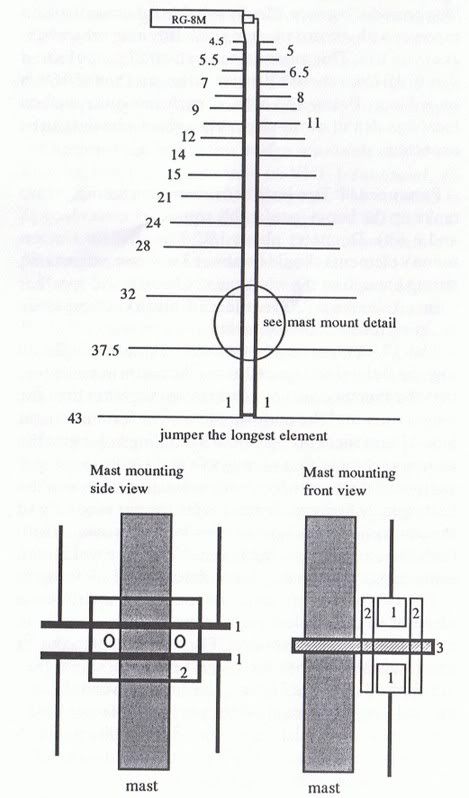Difference between revisions of "Tonsoffun"
From The RadioReference Wiki
| Line 20: | Line 20: | ||
To increase the low range of the antenna you can add more elements keeping up with a similar spacing. If doing that your boom lenght will increase. | To increase the low range of the antenna you can add more elements keeping up with a similar spacing. If doing that your boom lenght will increase. | ||
| − | Use your cable to feed the antenna at the end of the boom with the shortest elements. The centre conducter will connect to one boom, and the shield connects to the other boom. Tape the cable along the boom until you you can | + | Use your cable to feed the antenna at the end of the boom with the shortest elements. The centre conducter will connect to one boom, and the shield connects to the other boom. Tape the cable along the boom until you you can start going downwards along the mast. The longest elements are jumperd with a small lenght of wire. Element lenghts are indicated in centimeters. |
The compact size of this antenna makes it easy to handle and should not give you any problems to put together. You may need to use your imagination a bit during the construction to make things fit. | The compact size of this antenna makes it easy to handle and should not give you any problems to put together. You may need to use your imagination a bit during the construction to make things fit. | ||
Revision as of 20:16, 21 February 2008
This Log Periodic beam is very easy to build yourself with the available material at your local hardware store. The design is from a Haruteq Scanner Book I had and decided to give it a try. It works great on all scanner bands when you need to pin point and maximize your signal. The design shown is uni-directional and suitable for mounting on a tower or mast with a rotor to change it's listening area whenever you like.
The specifications shown for the LP in the book has an overall gain of about 8 to 10dB from about 130 Mhz to 900 Mhz, and has a 50 Ohm impedance. Below 130 Mhz it actually performs quite well on local signals and strong skip, although no miracles can be expected.
Parts you need to make this antenna:
- Two lenghts of aluminum (#1 on drawing below)to make the boom (preferably square or even angle) 1 meter long (3' and a bit)and diameter about 1/2" to 3/4".
- Antenna elements should be about 3 to 4mm (about 1/8") Strong enough that the wind can not bend it. The elements that I put on were 1/4" aluminum to make it really beefy. All together you are going to need about 6 m (20')of the element material.
- U-clamp (#3 on the drawing)
- Pieces of wood or plexi glass to keep the booms seperated (#2 on the drawing)
- Small wire to jumper the back of the LP
- Some very good coax to hook up to your scanner. On the drawing it shows rg-8m but I used LMR-400
The 17 elements on both sides of the beam (34 all together should be spaced along the boom in such a way that the shorter ones are a little closer together than the longer ones and the ends should almost form a straight line. Mount the elements on the boom by drilling holes into the aluminum tubing or angle. Get as snug a fit as possible for proper contact. If they are loose after inserting them into the holes you drilled, tightly wind some copper wire around the connections making sure the wires makes contact with both the element and the boom. You can cover it with some epoxy to keep it in place if needed.
For my antenna I actually threaded the ends of all the 1/4" elements about 1/2" to 3/4" of thread on the end of the aluminum rods so I can put them through the angle boom (or tubing) and bolt the elements in place. One nut above, then the nut on the bottom with some Loc Tight on both nuts.
The two booms are spaced about 3 cm. apart with a piece of wood or plexi glass screwed in between both ends to keep them seperated. They do not make contact except at the end with the longest element, where they are shorted out. The U-clamp mounts between the 2nd and the 3rd longest element. What you have so far looks like two combs, teeth sticking out in the opposite directions. A small piece of wood or plastic,2X3X3 acts as a stand off to keep the antenna away from the mast.
To increase the low range of the antenna you can add more elements keeping up with a similar spacing. If doing that your boom lenght will increase.
Use your cable to feed the antenna at the end of the boom with the shortest elements. The centre conducter will connect to one boom, and the shield connects to the other boom. Tape the cable along the boom until you you can start going downwards along the mast. The longest elements are jumperd with a small lenght of wire. Element lenghts are indicated in centimeters.
The compact size of this antenna makes it easy to handle and should not give you any problems to put together. You may need to use your imagination a bit during the construction to make things fit. I want to thank Bart Veerman for having this design available to us to use and experiment with.
